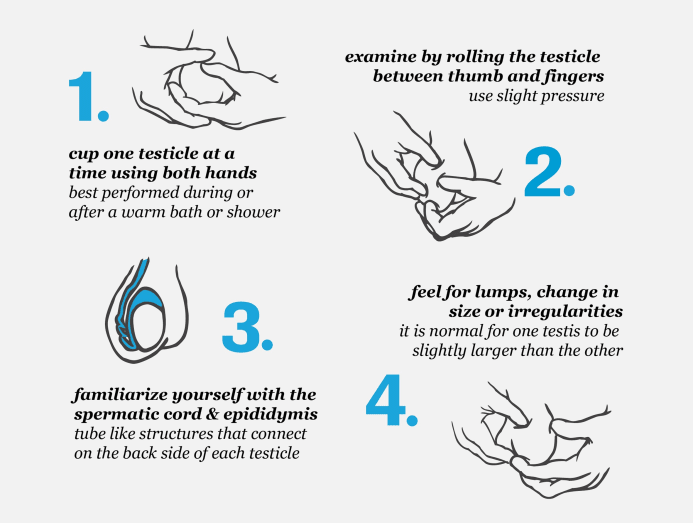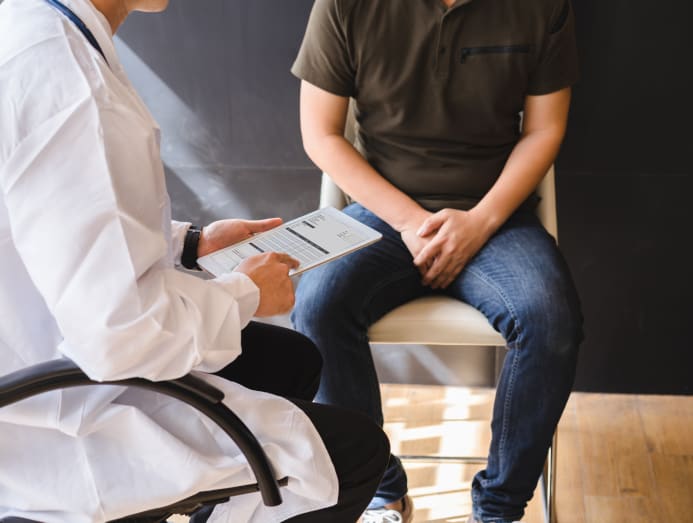Are you at risk of testicular cancer? A doctor explains the red flags to look out for
Advertising
Health
Are yous at chance of testicular cancer? A md explains the red flags to look out for
It represents a small percent of all cancers in men worldwide but the incidence charge per unit has steadily increased over the past few decades in Singapore. What should you lot be looking out for? Read on to detect out.

(Photograph: iStock/Quils)
17 November 2022 07:14AM (Updated: 17 November 2022 09:09AM)
Here'southward a question for men: O ther than the annual digital rectal examination for prostate cancer by your dr., which nosotros assume you lot have been diligently doing, when was the last fourth dimension you've actually examined things down in that location? And, yep, by that, we mean your testicles.
Like women, who should be performing monthly breast self-examinations for breast lumps, men should also exist conducting monthly self-examinations for lumps in the testicles, according to Dr Chong Weiliang, an associate consultant with Tan Tock Seng Hospital'south Section of Urology.
This is particularly important if you have a high take a chance of testicular cancer, he said.
"During this self-bank check, each testis should be examined for unusual lumps. If any is present, medical attention should exist sought and appropriate tests ordered," he explained.

Although testicular cancer represents a small pct (1 per cent to 2 per cent) of all cancers in men worldwide, the incidence rate has steadily increased over the past few decades in Singapore.
According to the Singapore Cancer Registry Annual Report, the number of cases has risen from 92 from 1998 to 2002, to 202 cases from 2022 to 2017.
"Thankfully, the absolute number remains relatively depression and, if diagnosed early, tin be treated successfully in the majority of cases," said Dr Chong.
If this has brought on more questions, for example, are you at risk if y'all've injured your groin expanse earlier or if yous're an avid cyclist, hither are some answers from Dr Chong:
| SCENARIOS | TESTICULAR CANCER RISKS |
| "I found a painless lump in my scrotum." | The lump may arise from the testis, cord structures or the skin, and they all conduct varying levels of cancer risks and management options. So seek medical attention equally soon as you can. |
| "I was striking or kicked in my scrotum before while playing sports/doing martial arts." | There is no modify in the risk of developing testicular cancer. |
| "I bicycle long distances every weekend." | Same as the above. |
| "I was born with only one testicle." | The of import question to ask is, what happened to the missing testis. Here a few possibilities:
|

WHAT ARE THE SIGNS OF TESTICULAR CANCER?
Testicular cancer can sometimes go unnoticed equally information technology could be present equally a painless, pea-sized lump in 1 of the testicles – and they tin can grow much bigger, according to Cancer.internet. In some cases, there may be swelling, pain, discomfort, numbness or a feeling of heaviness in the affected testicle.
What may also happen is 1 testicle may get firmer than the other, and at times, cause the afflicted side to grow or compress, noted the website.
In that location may be symptoms non related to the scrotum at all. These include a wearisome anguish in the lower belly or groin. For some young or middle-aged patients, developing a claret clot may be the offset sign of testicular cancer. Signs of such clots could be the swelling of one or both legs, or shortness of breath.
In later-stage testicular cancer, there may even be lower back hurting, shortness of breath, chest pain, and encarmine phlegm, according to Cancer.cyberspace.

WHO IS AT Adventure OF DEVELOPING TESTICULAR CANCER?
In case y'all think only elderly men who can't control their bladder well are at risk, yous'd exist wrong. According to Dr Chong, testicular cancer patients often fall in the age range of 20s to 40s.
A family history of testicular cancer is another risk factor. Having a father who suffers from information technology increases your risk by 4 times; and past 8 times if you have a brother who has the cancer.
HOW IS TESTICULAR CANCER DIAGNOSED?
Using a combination of physical examination as well as an ultrasound browse, according to Dr Chong. "The concrete test would commonly reveal a hard testicular lump, while the ultrasound scan would frequently show a mass arising from inside the testis."
If malignant, the scan would also pick up an increased blood flow to the lump and "possible invasion into the surrounding tissues, such as the spermatic string or the scrotum".
Blood tests for tumour markers, including alpha-fetoprotein, B human chorionic gonadotropin and lactate dehydrogenase, may also be ordered to decide the cancer type, said Dr Chong.

HOW IS THE CANCER TREATED?
Before any treatment is performed, sperm cyberbanking is advocated, said Dr Chong, as both surgery and chemotherapy can touch on the patient's fertility.
And then, the whole diseased testis and its cord volition exist removed through an inguinal incision, explained Dr Chong. "If picked up early on enough, this is sufficient to render the patient disease-free and would only require regular surveillance scans and blood tumour markers."
Still, he explained, if the cancer is deemed high gamble or if the disease has spread from the testis into the lymphatic system or beyond, chemotherapy would be required.
Should the cancer persist mail-chemotherapy, further surgery may be used to clear up the lymph nodes in the belly. "This surgery, known as a retroperitoneal lymph node dissection, is a major undertaking, and expert hands will be required to perform such a complex surgery," said Dr Chong.

WHAT IS TESTICULAR CANCER'S LINK TO HAVING HAD AN UNDESCENDED TESTICLE AS AN Infant?
"It isn't entirely articulate why a previously undescended testis can increase the adventure of testicular cancer," said Dr Chong, although there are some hypotheses.
During pregnancy, the testes really develop within the foetus' abdomen, just below the level of the kidneys, he explained. "Equally the testes mature, they progressively move downwards to take their place in each hemi-scrotum." This descent happens by the 26th to 28th weeks of the pregnancy, well earlier birth.
An undescended testis is an indication that its cells are "abnormal to begin with", said Dr Chong. Moreover, its undescended position later birth could farther expose the testis to an environment that induces cancerous mutations.
The latter is the reason why surgical correction is needed for an undescended testis by about xviii months, said Dr Chong. "It is to reduce the chance of hereafter malignancy and preserve fertility." However, this intervention does non nullify the baby'south risk of testicular cancer. Monthly cocky-examinations later in life are still required for the early detection of the cancer.

Only how common are undescended testicles in babies? "Globally, the incidence of an undescended testis in a full-term baby ranges from 1 per cent to 3 per cent, while a premature baby may have an incidence of upward to xxx per cent," said Dr Chong.
HOW DO You lot TELL IF A BABY HAS AN UNDESCENDED TESTICLE?
"Often, information technology appears as an absent, nether-developed hemi-scrotum, possibly with a testis felt in the groin on the same side," said Dr Chong. "Rarely exercise you have both testes being undescended."
If the condition is not picked upward during infanthood or childhood, the patient may notice an absent hemi-scrotum during adulthood, he said.
Source: https://cnalifestyle.channelnewsasia.com/wellness/testicular-cancer-checks-risk-treatment-287596
0 Response to "Are you at risk of testicular cancer? A doctor explains the red flags to look out for"
Post a Comment